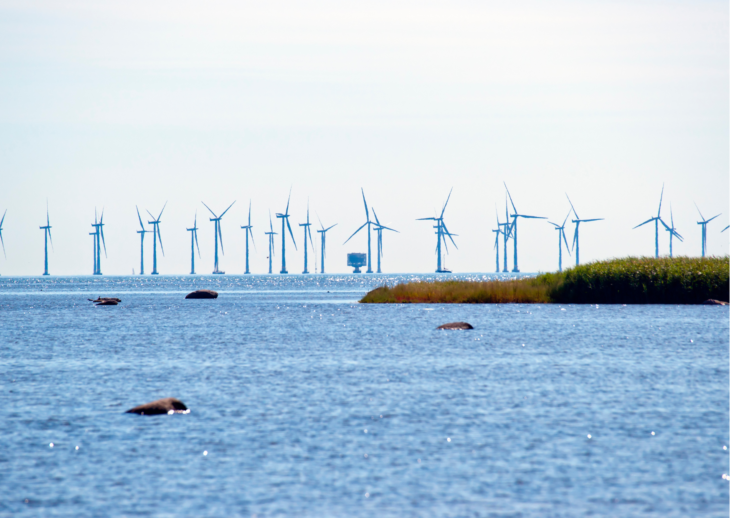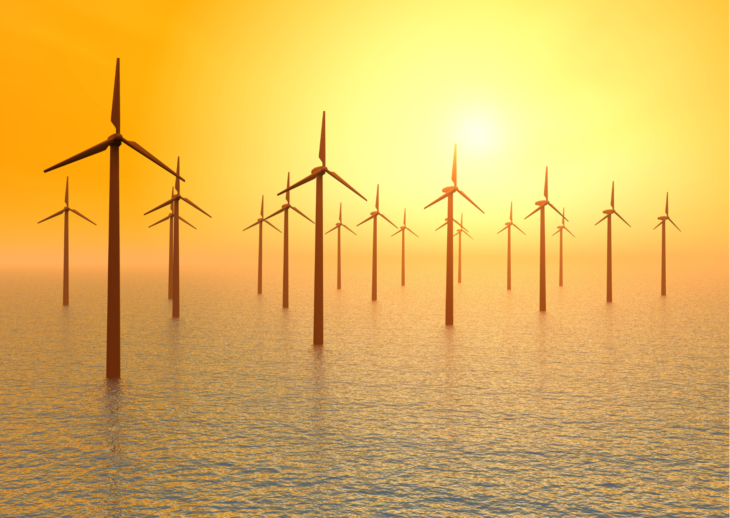The OGM Interactive Edition - Summer 2023 - Read Now!
View Past IssuesOffshore wind energy is gaining more attention globally as countries look for ways to reduce their carbon footprint and meet their renewable energy targets. Offshore wind projects offer several benefits, including a consistent wind resource, high capacity factors, and proximity to populated areas, making them a viable option for meeting the growing energy demands of many regions. This article will explore the opportunities, trends, and new markets in offshore wind energy, with a focus on North America.
The offshore wind energy industry is expanding rapidly, with new projects being announced regularly. According to the Global Wind Energy Council, the offshore wind industry is expected to grow at an annual rate of 17.4% between 2020 and 2025. This growth is driven by declining costs, technological advancements, and favorable government policies that incentivize renewable energy deployment.
Offshore wind energy presents several opportunities for various stakeholders. Investors can take advantage of attractive returns, developers can benefit from economies of scale, and governments can create jobs and reduce their carbon emissions. Additionally, offshore wind projects can bring benefits to local communities, such as job creation, economic development, and tax revenue.
One of the key trends in offshore wind energy is the increasing size of wind turbines and projects. As technology improves, wind turbines are becoming larger and more efficient, allowing developers to generate more electricity from fewer turbines. Larger projects are also becoming more common, with developers seeking economies of scale and lower costs per megawatt-hour of electricity generated.
Another trend is the growing use of floating wind turbines, which allow projects to be installed in deeper waters, where wind resources are often stronger and more consistent. Floating turbines can also be deployed further offshore, reducing visual impacts and noise for coastal communities. Many of the offshore oil and gas industry products, services, and processes are transferrable to the offshore wind sector.
Regions like Newfoundland and Nova Scotia that have already existing oil and gas infrastructure are natural development regions for offshore wind. Given Newfoundland is one of the windiest places on earth, the region lends well to the development of a lucrative offshore wind industry.

The winds of change are blowing in Canada as the federal government, Nova Scotia, Newfoundland, and Labrador are clearing the way for offshore wind development. This landmark direction marks a significant step forward towards a greener, more sustainable future for Canada.
With a timeframe in mind, the federal government, Nova Scotia, Newfoundland and Labrador have been working to develop plans for offshore wind development. Plans include the creation of a regulatory framework that will ensure environmental protection and responsible development of offshore wind projects. The regulatory framework will provide a clear and transparent process for developers to follow, ensuring that all projects are environmentally responsible and sustainable. This framework will include measures to protect marine life, including whales and other endangered species, as well as measures to ensure that wind turbines are constructed in areas that minimize the impact on fishing and shipping industries.
Offshore wind development is a critical component of Canada’s transition to a low-carbon economy and the fight against climate change. The potential for offshore wind energy in Canada is enormous, with an estimated 170 GW of potential capacity off the Atlantic coast alone. This capacity represents a significant opportunity for Canada to become a world leader in offshore wind energy and reduce its dependence on fossil fuels.
The first step towards realizing this potential is the creation of a regulatory framework that provides a clear path for responsible offshore wind development. The next step is the development of offshore wind projects that meet the standards outlined in the regulatory framework. This will require collaboration between energy companies, environmental groups, and communities to ensure that projects are developed in a responsible and sustainable manner.
The first commercial-scale offshore wind project in Canada is scheduled to be in 2025 in Nova Scotia, with a goal of reaching 5 GW of capacity by 2030. This goal is ambitious but achievable, and it represents a significant step towards a more sustainable future for Canada.
The United States is one of the newest markets for offshore wind energy, with several interesting mega-projects in various stages of development. Establishing a Target of Employing Tens of Thousands of Workers to Deploy 30 Gigawatts (30,000 megawatts) of Offshore Wind by 2030 while protecting biodiversity and promoting ocean co-use.
Meeting this target will attract more than $12 billion per year in capital investment in projects on both US coasts, create tens of thousands of good-paying, union jobs, with more than 44,000 workers employed in offshore wind by 2030 and nearly 33,000 additional jobs in communities supported by offshore wind activity. Offshore Wind in the US will also generate enough power to meet the demand for more than 10 million American homes for a year, and avoid 78 million metric tons of CO2 emissions.
Vineyard Wind - Massachusetts
Vineyard Wind is a joint venture between Avangrid Renewables and Copenhagen Infrastructure Partners that is developing an 800 MW offshore wind project off the coast of Massachusetts. The project is expected to be operational by 2023 and will provide enough electricity to power over 400,000 homes.
South Fork Wind - New York
South Fork Wind is being developed by Ørsted and Eversource and will be a 130 MW offshore wind project off the coast of Long Island, New York. The project is expected to be operational by 2023 and will provide enough electricity to power over 70,000 homes.
Ocean Wind - New Jersey
Ocean Wind is being developed by Ørsted and PSEG and will be a 1.1 GW offshore wind project off the coast of New Jersey. The project is expected to be operational by 2024 and will provide enough electricity to power over 500,000 homes.
Revolution Wind - Rhode Island
Revolution Wind is being developed by Ørsted and Eversource and will be a 700 MW offshore wind project off the coast of Rhode Island. The project is expected to be operational by 2023 and will provide enough electricity to power over 300,000 homes.
Park City Wind - Connecticut
Park City Wind is being developed by Ørsted and Eversource and will be an 804 MW offshore wind project off the coast of Connecticut. The project is expected to be operational by 2025 and will provide enough electricity to power over 400,000 homes.
Skipjack Wind - Maryland
Skipjack Wind is being developed by Ørsted and will be a 120 MW offshore wind project off the coast of Maryland. The project is expected to be operational by 2026 and will provide enough electricity to power over 40,000 homes.
Coastal Virginia Offshore Wind - Virginia
Coastal Virginia Offshore Wind is being developed by Dominion Energy and will be a 2.6 GW offshore wind project off the coast of Virginia. The project is expected to be operational by 2026 and will provide enough electricity to power over 650,000 homes.
Kitty Hawk Offshore Wind - North Carolina
Kitty Hawk Offshore Wind is being developed by Avangrid Renewables and will be a 2.5 GW offshore wind project off the coast of North Carolina. The project is still in the planning stages, but if approved, it will be one of the largest offshore wind projects in the world.
Empire Wind - New York
Empire Wind is being developed by Equinor and BP and will be a 2 GW offshore wind project off the coast of New York. The project is expected to be operational by 2024 and will provide enough electricity to power over 1 million homes.
Mayflower Wind - Massachusetts
Mayflower Wind is being developed by Shell and EDPR and will be an 804 MW offshore wind project off the coast of Massachusetts. The project is expected to be operational by 2025 and will provide enough electricity to power over 500,000 homes.

Many of these projects have procurement opportunities for companies interested in providing goods or services to developers. Interested parties can find information on these opportunities on the developers’ websites or on government procurement websites.
The Department of Energy’s Wind Energy Technologies Office: https://www.energy.gov/eere/wind/wind-energy-technologies-office
The National Renewable Energy Laboratory’s offshore wind website: https://www.nrel.gov/wind/offshore-wind.html
The Business Network for Offshore Wind: https://www.offshorewindus.org/
Offshore wind energy presents significant opportunities for investors, developers, and governments, as well as benefits for local communities. With the increasing demand for clean energy and the declining cost of offshore wind technology, the offshore wind industry is expected to continue growing in the coming years.
Canada has significant potential for offshore wind energy development, particularly on the east coast, where the wind resource is strong and the water depths are suitable for the installation of turbines. The Canadian government has set a target of achieving net-zero greenhouse gas emissions by 2050, which includes a significant increase in renewable energy generation. Offshore wind is expected to play a key role in meeting these targets.
Nova Scotia, Newfoundland and Labrador, and New Brunswick are the most likely areas for offshore wind development, but there is also potential in the Gulf of Saint Lawrence and in Western Canada offshore BC. All in all, we can expect very exciting times ahead in offshore wind for North America.
Did you enjoy this article?